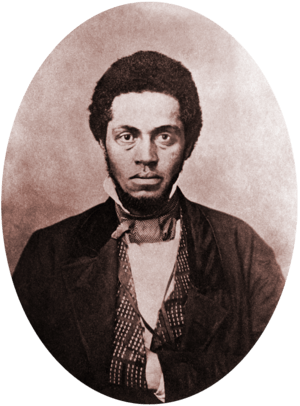Osborne Perry Anderson facts for kids
Osborne Perry Anderson (born July 27, 1830 – died December 11, 1872) was an African-American person who worked to end slavery, known as an abolitionist. He was the only African-American member to survive John Brown's raid on Harpers Ferry, West Virginia. Later, he became a soldier in the Union Army during the American Civil War.
Contents
Early Life and Freedom
Osborne Perry Anderson was born free in 1830 in West Fallow Field Township, Chester County, Pennsylvania. Being born free meant he was not enslaved, which was very important at that time. He went to school and later attended Oberlin College in Ohio.
In 1850, he moved to Chatham in Canada West, which is now Ontario, Canada. There, he started his own printing business. His skills as a printer would become very useful in his fight against slavery.
Anderson also joined the Chatham Vigilance Committee. This group worked to protect formerly enslaved people who had escaped to Canada. They made sure these individuals were not captured and forced back into slavery in the United States.
Joining John Brown's Fight
In May 1858, Anderson met John Brown, a famous abolitionist who believed in using force to end slavery. Anderson learned about Brown's big plan to start a rebellion against slavery at a meeting in Chatham.
Because Anderson was good at writing, he became the recording secretary for several of Brown's meetings. This meant he wrote down what happened and what was decided. He eventually became a member of Brown’s special planning group.
The Harpers Ferry Raid
During the raid on Harpers Ferry, Anderson was with another raider named Albert Hazlett. Their goal was to seize weapons and inspire enslaved people to join their fight for freedom.
During the raid, a relative of George Washington, named Col. Lewis Washington, was taken hostage. He gave up a special sword and pistols to Anderson. John Brown later used this sword while leading his men.
When it became clear that the raid was not going to succeed, Anderson and Hazlett managed to escape to Pennsylvania. Sadly, Hazlett was later caught and executed. Anderson, however, was able to continue his journey to freedom.
A Voice from Harper's Ferry
After the raid failed, Osborne Perry Anderson wrote a book about his experiences. It was called A Voice From Harper’s Ferry. This book is very important because it is a firsthand account from one of the few survivors of the raid.
In his book, Anderson described what it was like during the Harpers Ferry raid. He wrote about the training the group received, the supplies they had, and the events that happened before and after the raid. He stated that he was the only person who was with John Brown for the entire raid and survived.
Anderson did not name the people who helped him escape in his book. However, we now know that William C. Goodridge, who was part of the Underground Railroad, helped hide him in York, Pennsylvania. From there, Anderson traveled by train to Philadelphia and then to Canada, where he was safe.
Life After the Raid
When the American Civil War began, Osborne Perry Anderson joined the Union Army. He became a noncommissioned officer, which is a leader who is not an officer but has important responsibilities.
Later in his life, in October 1872, people in Philadelphia collected money to help him because his health was not good. He thanked them, mentioning his poor health. He also received money from people in Washington D.C.
Osborne Perry Anderson died in Washington D.C. within a week of receiving the last collection, in December 1872. He was buried at Columbian Harmony Cemetery. Later, all the bodies from that cemetery were moved to National Harmony Memorial Park in Landover, Maryland.
Legacy
Osborne Perry Anderson's story continues to be remembered.
- A play called The Journals of Osborne P. Anderson, written by Ted Lange, was performed in Winston-Salem, North Carolina, in 2015.


